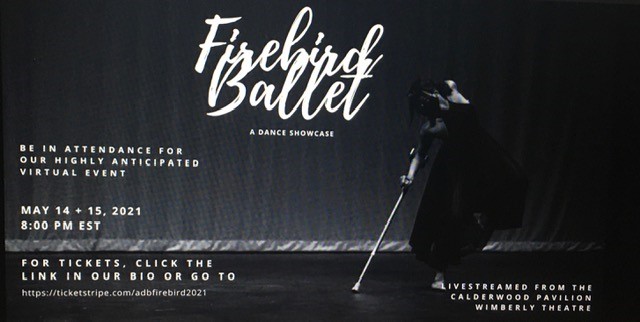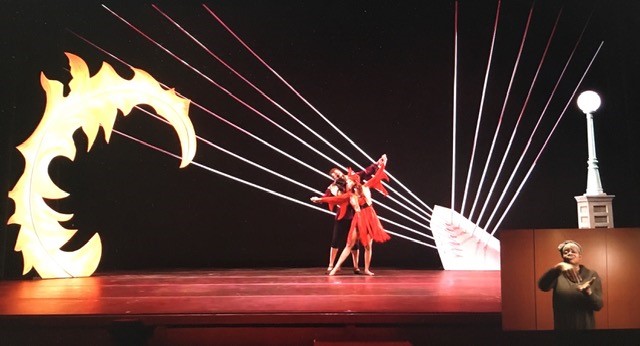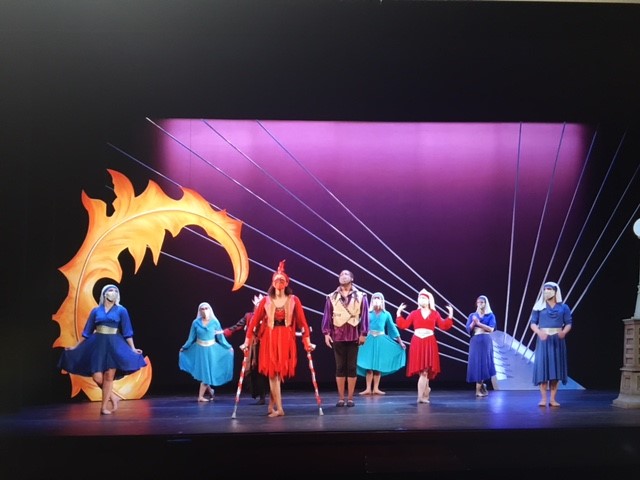
Crappy screencap of a screen photos by Kitty Drexel
Presented by Abilities Dance Boston
Based on the Slavic firebird folktale
Choreography by Ellice Patterson with the ensemble
Music composed and directed by Andrew Choe
The Firebird program has full cast and crew information
May 14 & 15, 2021
Livestreamed from the Wimberly Theatre at the Calderwood Pavillion
Boston, MA
Abilities Dance on Facebook
Critique by Kitty Drexel
BOSTON/YouTube — The pressure to create during quarantine reached monstrous enormity. For every normie Tom, Delia, and Harrison Ford who worked on a script because Lear was written during a pandemic, an artist with a resume of successes couldn’t polish their abilities because they were too busy surviving the next 24-hours.
Survival for the disabled arts community means something very different than it does the abled community. Jobs for disabled artists didn’t merely dwindle. They vanished overnight. Some of those jobs may never reappear.
Our priorities went from managing a job to managing continued existence in a world actively trying to kill them: doctors appointments and surgeries were canceled, elevators became vectors for disease, carers were transferred to essential service positions. We went from demanding plastic straws in restaurants to demanding our right to live at all. It felt like ableds weren’t going to permit us either thing.
As a physically disabled, neuro-atypical person, there were days I couldn’t get out of bed, much less perform my physical therapy exercises, show up to my support job for eight hours, function as an adult, and practice my music and writing. I had to keep my support-job so I could make rent and buy meds; I used my laptop in bed. I had to do my physical therapy; Maybe my body wouldn’t atrophy any more than it had in 39 years. Capable-adult function and my soul-fulfilling arts work got the chop. Goodbye, executive function and daily arts practice; hello, canned vegetables and historical romance novels on repeat.
That Abilities Dance was able to produce two concerts during a pandemic given all of the odds stacked unreasonably high against them (and when other companies have not produced anything) is a point of pride. They are coming out of quarantine with impressive credits and production clout. I wrote about their Celebrity Series of Boston Debut at the Wimberly Theatre HERE. It was a stepping stone to Firebird.
Abilities Dance’s Firebird resembles the Russian fairy tale but not the famous Stravinsky Firebird Suite (L’Oiseau du feu). According to Slavic legend, Prince Ivan battles the great magician, Koschei the Deathless, to free 13 princesses from enslavement. Ivan uses a magic feather from a magnificent Firebird, a large falcon that glows and burns like a bonfire that never extinguishes, to escape Koschei and free the princesses .

A duet between the Firebird (Patterson) and the Prince (Hunter). Plus ASL interpreter in the right corner.
The ballet by Abilities Dance does not name Ivan, Koschei, or the Princesses by name. Instead, characters are kept as neutral as possible. Genders were often swapped – thereby proving that there are many valid ways to be a princess. Each dancer had an opportunity to express their character through dance that suited their skills, range and capability.
A Prince (Antoine Hunter) meets a Firebird (Ellice Patterson) in the wilds of Central Massachusetts. The Firebird tells him of Princesses captured by an evil Queen (Louisa Mann) who has also enslaved locals to be her minions. The Princess and a brace Princess (Zahna Simon) encounter the evil, capitalist Queen. They are all- even the Queen -liberated by the grace of the Firebird. Late-stage capitalism was the villain all along.
Firebird is a triumph of accessibility. Thanks to Zoom technological innovations, streamed video was captioned. An expressive ASL interpreter who acted out all of the roles with panache was added to the live stream. They appeared in a small box in the right hand corner of my YouTube box.
Audio descriptions by Patterson added great depth to the performance. In describing the set design by Janie E. Howland, Patterson depicted the stage-left bridge cabling as “the wires of the Zakim (gone) amok in space.” It’s a great way to characterize Howland’s set. The cables stretch far into an unknown distance. Farther stage left, a lit lamppost is a beacon that calls the Firebird like a moth. A gigantic flame permanently pierces the air on stage like alien foliage on stage right. Action on the stage occurs between both.
Patterson said that the Firebird and Prince danced “like two lovers in the night.” A pirouette was a spin like a “ballerina in a jewelry box.” Best yet, Patterson described the furious dancing of a trapped minion as “to the screech of her suffocating thoughts.” This isn’t your average audio description; it’s storytelling accompaniment and an equal component of conveying the performance to the blind and visually impaired.
A. Laura Brody’s costumes incorporated masks into their design. Dancers were well dressed and safe. The costumes fit well, flexible (there were some impressive leg extensions choreographed into the ballet), and conveyed the Firebird story.
I must admit that I am at a loss when it comes to critiquing technique and talent for this production. The old/ableist ways of judging a performance had a critic comparing strength, dexterity, emotional vulnerability, acting skill, beauty of movement and artistic intention. Most of these points must be renounced in critiquing the art of the disabled. The same standards don’t apply. Those standards are nearly obsolete anyway.
A theatre critic must ask a three-part question: What was the artist trying to do? Did they do it? Were they impactful? As theatre goes, Firebird was greatly successful art. Abilities Dance intended to create a Firebird ballet. They did that. It impacted me in ways that I’m still hashing out nearly a week later. It’s mind-blowing to see my disabled body represented on stage.

A cast bow. It was well-earned.
I appreciated Firebird’s anti-capitalist, nonbinary & genderqueer, and self-acceptance spins on this traditional fairy tale. The Firebird at one point says/thinks, “Just because I can save the day, doesn’t mean I should.” Many people can identify with that statement. The pandemic has put undue stress on disabled bodies. We were called upon to sacrifice ourselves so ableds might live, so ableds might love. Just because we disabled are asked to die, it doesn’t mean we must acquiesce. It’s better to burn brightly alone like the Firebird than to extinguish our flames in death for the benefit of others.
The pandemic was cruel to everyone but it didn’t take equitably. The greater populace turned to music, dance, theatre, visual arts, and crafting for succor as the burden (and death count) grew. Artists and cultural creators were all but abandoned by the US government in their time of need. The fringe and freelance artists were left in the lurch. Many artists were forced out of their art.
The talented dancers of Abilities Dance have a community with their community. But even they have a tenuous hold on financial stability. Theatres aren’t known for their solvency. Please, for the love of jumping jehosaphat, donate. Donating to Zoom performances now gives performing organizations the chance at existing when live-performances aren’t a death sentence to immuno-compromised individuals once it’s safe to reunite in-person again.
- National Endowment for the Arts Resources: https://www.arts.gov/about/nea-on-covid-19/resources-for-artists-and-arts-organizations
- StageSource Resources: https://www.stagesource.org/page/covid19
Update 5/21/21: A previous version of this article attributed the audio descriptions to Amber Pearcy. They were written by Ellice Patterson.
